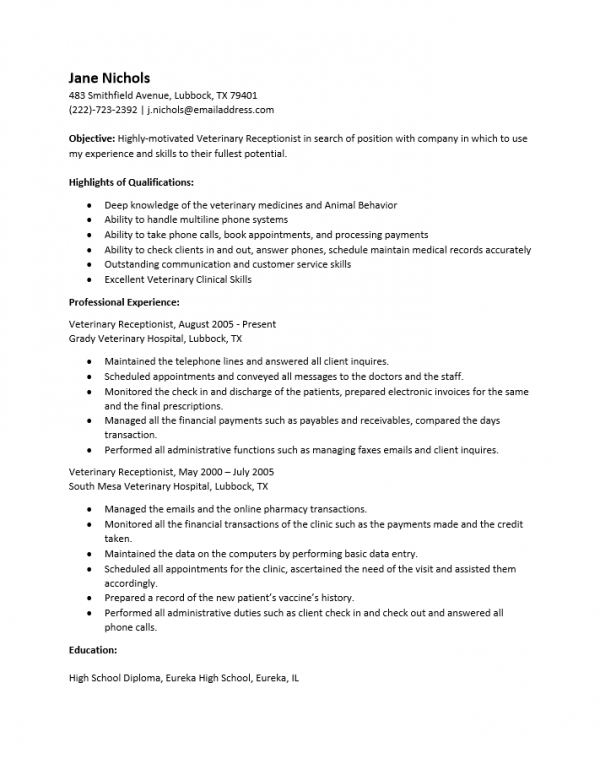
|
Veterinary Receptionist Resume Template |
The Veterinary Receptionist Resume Template gives a definitive structure for those wishing to focus on content. A veterinary receptionist will need to demonstrate both knowledge of office procedures and of animal care. For instance it is not unusual for a receptionist in this field to be required to give instructions when an animal must be brought in for a procedure. It is also very necessary for a veterinary receptionist to possess skills such as billing, managing the front office, and be adept at dealing with very worried or irate pet owners at time. Obviously, they may be called upon to handle an animal at times and thus, should be comfortable around and in dealing with animals.
Front of office operations will require quite a bit of technical knowledge in addition to some of the specialized skills needed to function well in a veterinary office. A resume in this field must be chock full of applicable content that will highlight valuable skills. This makes time consuming tasks such as repeated formatting when attempting to quickly customize a resume highly undesirable. A template will remove such a frustration by providing a set structure for this document. In order to reach the goal of an interview, one must be prepared to make sure their resume is quickly delivered, flawless, and intelligent.
How to Write
Step 1. Your name should be prominently displayed at the top of the resume. It is generally advisable to add an effect to it…such as enlarging the font or perhaps putting it in bold. This will make it easy to notice and memorable.
Step 2. Your contact information should immediately follow your name. This is how a hiring entity wishing an interview will contact you, so use up to date information. If you do not have a professional sounding email address then it would be wise to create one for a job search.
Step 3. The “Job Objective” section acts as an introduction of sorts. This is a place where you should directly state your intention to attain the position in question. Try to write a sentence or two selling yourself here but keep it brief.
Step 4. The next section, titled “Highlights of Qualifications,” should specifically bridge your skills and knowledge with the job requirements. This is a section where technical jargon and applicable buzzwords would be welcome. This should be in the form of a list to keep it manageable.
Step 5. The “Professional Experience” section is arguably one of the most important sections. This will provide an employment track record and show you can handle the job being applied to. Be as brief and self-complimentary as possible. It will be a list of previous employers in descending date order. The first line of each employer entry should contain your official job title and dates worked for that employer. The second line should have the name of the employer and the city/state where you worked. The rest of the entry must contain a description of your responsibilities there. If you have earned any notoriety include this as well.
Step 6. The “Education” section will list your academic credentials. This can be vital in some instances so include any degrees, diplomas, and certifications you have earned. Make sure to give specifics such as the name of the school, location, and official degree title. Include anything that may seem impressive (i.e. nominations, awards, advanced programs).


